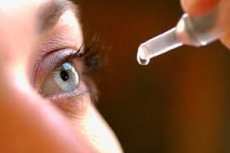Medical expert of the article
New publications
Technique of putting drops in the eyes
Last reviewed: 04.07.2025

All iLive content is medically reviewed or fact checked to ensure as much factual accuracy as possible.
We have strict sourcing guidelines and only link to reputable media sites, academic research institutions and, whenever possible, medically peer reviewed studies. Note that the numbers in parentheses ([1], [2], etc.) are clickable links to these studies.
If you feel that any of our content is inaccurate, out-of-date, or otherwise questionable, please select it and press Ctrl + Enter.

Self-instillation
There are several ways to administer the drops. The two-handed method: The patient should tilt their head back so that their gaze is directed upward. With the thumb and ring finger of their non-dominant hand, the patient should hold the upper and lower eyelids of the eye so that they do not close. With their dominant hand, the patient brings the bottle of drops to the eye and administers the drops.
In cases of tremor or severe weakness, this method may not be available, in which case an alternative method using one hand is used. The patient should tilt their head back so that their gaze is directed upward. They should hold the bottle of drops with their dominant hand so that it rests on the bridge of their nose. The tip of the bottle should be positioned above the eye. By squeezing the bottle, the drops should be instilled. With this technique, the patient's nose helps hold the bottle while instilling the drops.
 [ 1 ], [ 2 ], [ 3 ], [ 4 ], [ 5 ]
[ 1 ], [ 2 ], [ 3 ], [ 4 ], [ 5 ]
Point occlusion
Excess drops are often excreted through the lacrimal system of the eye and then enter the nose. Absorption of the drug by the nasal mucosa can significantly enhance its systemic action. Enhanced systemic absorption usually does not affect the action of the drug in the eye, since most drugs penetrate well into the cornea, creating a sufficient concentration to saturate the receptors inside the eye. However, enhanced systemic absorption usually increases the likelihood of unwanted systemic side effects.
Point occlusion with a finger minimizes the drug getting on the nasal mucosa. To do this, the patient should simply press the common lacrimal ducts (angle of the nose) with their fingers.

